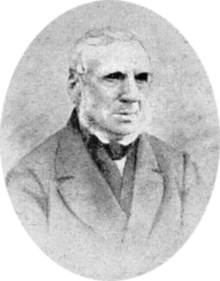James FitzGibbon
This article needs additional citations for verification. (August 2010) |
James FitzGibbon | |
|---|---|
 | |
| Born | 16 November 1780 Glin, County Limerick, Ireland |
| Died | 10 December 1863 (aged 83) London, England |
| Allegiance | Great Britain United Kingdom Upper Canada |
| Service/ | British Army Colonial militia in Canada |
| Years of service | 1795–1825, 1837 |
| Rank | Captain |
| Battles/wars | War of 1812 Upper Canada Rebellion |
James FitzGibbon (16 November 1780 – 10 December 1863) was an Irish soldier in the War of 1812.[1]
Early life and career[]
Born to Garrett (Gerald) FitzGibbon and Mary Widenham in Glin, County Limerick, Ireland, he enlisted in the Knight of Glin's Yeomanry Corps at age 15.[2] Three years later, he joined the Tarbert Infantry Fencibles, an Irish home service regiment, from which he was recruited into the British Army's 49th Regiment of Foot as a private soldier.[3] He first fought in battle in 1799 at Egmond aan Zee, the Netherlands. He later served as a marine in the Battle of Copenhagen, for which he received the Naval General Service Medal.
Arrival in Canada[]
He went to Canada in 1802, by which time he was a sergeant. He played a key role in the suppression of a near-mutiny at Fort George, Ontario.[citation needed] In 1806, when he was the regiment's Sergeant-Major, his commanding officer, Isaac Brock, made him an officer. This was extremely unusual at the time as most officers' commissions were bought.[citation needed] Later the same year he was appointed regimental adjutant. In 1809, he was promoted to the rank of Lieutenant.
War of 1812[]
FitzGibbon fought at the Battle of Stoney Creek on 6 June 1813. Three weeks later, he led 50 soldiers in guerrilla-style raids on a large American force that had captured Fort George on the Niagara Peninsula. It was he who was warned by Laura Secord on 22 June about an impending surprise attack by 500 American troops.[4] This led to the Battle of Beaver Dams near present-day Thorold, Ontario, where FitzGibbon's force, together with about 400 Mohawk and Odawa warriors, defeated the Americans and took 462 prisoners. The victory made FitzGibbon a popular hero and he was promoted to Captain in the Glengarry Light Infantry Fencibles. In 1814 he fought at the Battle of Lundy's Lane.
Post-war activities[]
After the war, FitzGibbon retired on half-pay and became a clerk in the office of the Adjutant-General of the militia. He was later promoted to Assistant Adjutant-General.[5]
In 1818, FitzGibbon responded to accusations from Robert Gourlay that the Lieutenant-Governor thought Canadians were disloyal and ungrateful British subjects.[6] In 1824 the Lieutenant-Governor of Upper Canada Peregrine Maitland sent FitzGibbon to negotiate an end to riots in the Bathurst District of York between Irish settlers and previous residents.[5] A year later newspapers in Upper Canada questioned the loyalty of Irish immigrants and FitzGibbon wrote editorials defending the immigrants.[7]
In 1826, FitzGibbon initiated a campaign to help the defendants of the Types Riot pay their settlement to Mackenzie.[8] He denied accusations by Francis Collins in the Canadian Freeman that Maitland contributed to the fund but did not deny his involvement or contributions from other government administrators.[9]
During the Upper Canada Rebellion of 1837, FitzGibbon was appointed Acting Adjutant-General of Militia. He organised and led the forces that defended Toronto from William Lyon Mackenzie's rebel force.[2]
Later life and legacy[]
He moved to England in 1847 after the death of his wife Mary Haley, with whom he had four sons and a daughter. In 1850 he was appointed a Military Knight of Windsor.
He died at Windsor Castle in 1863 and is buried there in the crypt of St. George's Chapel.
In 2003 his descendants donated some of his personal effects, including a signet ring and a ceremonial sword, to the Canadian War Museum in Ottawa.
In popular culture[]
FitzGibbon appears in The Bully Boys, a novel by Eric Walters.[10] The book follows his interactions with fictional character Thomas Roberts, whom he takes under his wing during the events surrounding the Battle of Beaver Dams.
References[]
- ^ Ridler, Jason. "James FitzGibbon". The Canadian Encyclopedia. Retrieved 8 May 2017.
- ^ Jump up to: a b "McKenzie, Ruth. FITZGIBBON, JAMES, Dictionary of Canadian Biography". Retrieved 23 July 2010.
- ^ Villemaire, Tom; Network, Special to Postmedia. "An outstanding soldier, but his career cost him". Toronto Sun. Retrieved 8 May 2017.
- ^ "McKenzie, Ruth. INGERSOLL, LAURA (Secord), Dictionary of Canadian Biography". Retrieved 8 June 2010.
- ^ Jump up to: a b Raible, Chris (1992). Muddy York Mud: Scandal & Scurrility in Upper Canada. Toronto: Curiosity House. p. 134. ISBN 978-0-9696418-0-3.
- ^ Raible, Chris (1992). Muddy York Mud: Scandal & Scurrility in Upper Canada. Toronto: Curiosity House. p. 133. ISBN 978-0-9696418-0-3.
- ^ Raible, Chris (1992). Muddy York Mud: Scandal & Scurrility in Upper Canada. Toronto: Curiosity House. p. 135. ISBN 978-0-9696418-0-3.
- ^ Raible, Chris (1992). Muddy York Mud: Scandal & Scurrility in Upper Canada. Toronto: Curiosity House. p. 131. ISBN 978-0-9696418-0-3.
- ^ Raible, Chris (1992). Muddy York Mud: Scandal & Scurrility in Upper Canada. Toronto: Curiosity House. pp. 131–132. ISBN 978-0-9696418-0-3.
- ^ "The Bully Boys". Eric Walters. Retrieved 21 April 2017.
External links[]
- 1780 births
- 1863 deaths
- 18th-century Irish people
- 19th-century Irish people
- People from County Limerick
- Upper Canada Rebellion people
- British Army personnel of the French Revolutionary Wars
- British Army personnel of the War of 1812
- 49th Regiment of Foot officers
- Royal Berkshire Regiment soldiers
- British colonial army officers
- Irish officers in the British Army
- Military Knights of Windsor
- Pre-Confederation Ontario people
- Canadian Militia officers
